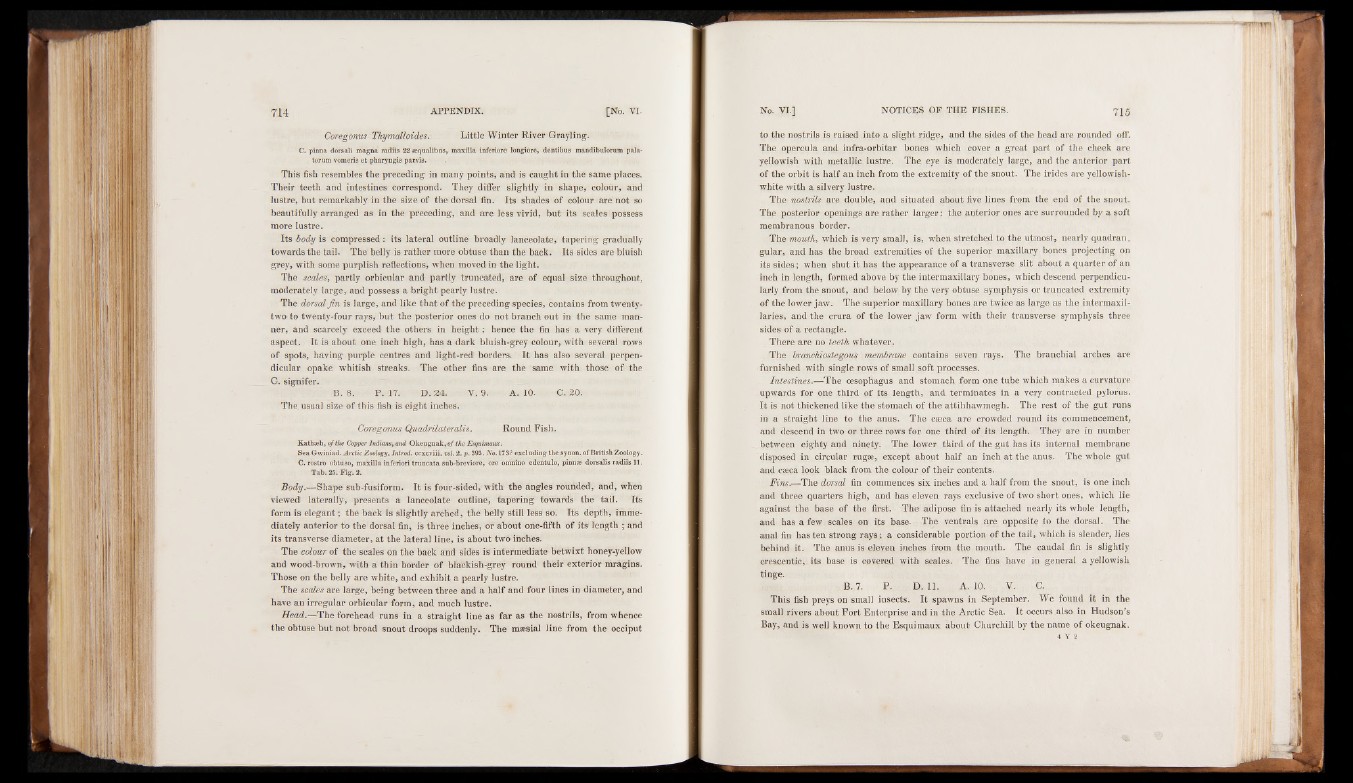
Coregonus Thymalloides. Little Winter River Grayling.
C. pinna dorsali inagna radiis 22 sequalibris, maxilla inferiore longiore, dentibus mandibulorum pala-
torum vomeris et pharyngis parvis.
This fish resembles the preceding in many points, and is caught in the same places.
Their teeth and intestines correspond. They differ slightly in shape, colour, and
lustre, but remarkably in the size of the dorsal fin. Its shades of colour are not so
beautifully arranged as in the preceding, and are less vivid, but its scales possess
more lustre.
Its body is compressed: it's lateral outline broadly lanceolate, tapering gradually
towards the tail. The belly is rather more obtuse than the back. Its sides are bluish
grey, with some purplish reflections, when moved in the light.
The scales, partly orbicular and partly truncated, are of equal size throughout,
moderately large, and possess a bright pearly lustre.
The dorsal jin is large, and like that of the preceding species, contains from twenty-
two to twenty-four rays, but the posterior ones do not branch out in the same manner,
and scarcely exceed the others in height; hence the fin has a very different
aspect. It is about one inch high, has a dark bluish-grey colour, with several rows
of spots, having purple centres and light-red borders. It has also several perpendicular
opake whitish streaks. The other fins are the same with those of the
C. signifer.
B. 8. P.47. D. 24. V, 9. A. 10. G. 20.
The usual size of this fish is eight inches.
Coregonus Quadrilateralis. Round Fish.
Kathseh, of the Copper Indians, and Okeugnak, o/ the Esquimaux.
Sea Gwiniad. Arctic Zoology. Introd. ccxcviii. vol. 2. p. 393. No. 173 ? excluding the synon. of British Zoology.
C.rostro obtuso, maxilla inferiori truncata sub-breviore, ore omnino edentulo, pinnas dorsalis radiis 11.
Tab. 25; Fig. 2.
Body.—Shape sub-fusiform. It is four-sided, with the angles rounded, and, when
viewed laterally, presents a lanceolate outline, tapering towards the tail. Its
form is elegant; the back is slightly arched, the belly Still less so. Its depth, immediately
anterior to the dorsal fin, is three inches, or about one-fifth of its length ; and
its transverse diameter, at the lateral line, is about two inches.
The colour of the scales on the back and sides is intermediate betwixt honey-yellow
and wood-brown, with a thin border of blackish-grey round their exterior mragins.
Those on the belly are white, and exhibit a pearly lustre.
The scales are large, being between three and a half and four lines in diameter, and
have an irregular orbicular form, and much lustre.
Head.—The forehead runs in a straight line as far as the nostrils, from whence
the obtuse but not broad snout droops suddenly. The maesial line from the occiput
to the nostrils is raised into a slight ridge, and the sides of the head are rounded off.
The opercula andi infra-orbitar bones which cover a great part of the cheek are
yellowish with metallic lustre. The eye is moderately large, and the anterior part
of the orbit is half an inch from the extremity of the snout. The irides are yellowish-
white with a silvery lustre.
The nostrils are double, and situated about five lines from the end of the snout.
The posterior openings are rather larger: the anterior ones are surrounded by a soft
membranous border.
The mouth, which is very small, is, when stretched to the utmost, nearly quadran.
gular, and has the broad extremities of the superior maxillary bones projecting on
its sides; when shut it has the appearance of a transverse slit about a quarter of an
inch in length, formed above by the intermaxillary bones, which descend perpendicularly
from the snout, and below by the very obtuse symphysis or truncated extremity
of the lower jaw. The superior maxillary bones are twice as large as the intermaxil-
laries, and the crura of the lower jaw form with their transverse symphysis three
sides of a rectangle.
There are no teeth whatever.
The bmnckiostegous membrane contains seven rays. The branchial arches are
furnished with single rows of small soft processes.
Intestines.—The oesophagus and stomach form one tube which makes a curvature
upwards for one third of its length, and terminates in a very contracted pylorus.
It is not thickened like the stomach of the attihhawmegh. The rest of the gut runs
in a straight line to the anus. The caeca are crowded round its commencement,
and descend in two or three rows for one third of its length. They are in number
between eighty and ninety. The lower third of the gut has its internal membrane
disposed in circular rugae, except about half an inch at the anus. The whole gut
and caeca look black from the colour of their contents.
FVm,—The dorsal fin commences six inches and a half from the snout, is one inch
and three quarters high, and has eleven rays exclusive of two short ones, which lie
against the base of the first. The adipose fin is attached nearly its whole length,
and has a few scales on its base. The ventrals are opposite to the dorsal. The
anal fin hasten strong rays; a considerable portion of the tail, which is slender, lies
behind it. The anus is eleven inches from the mouth. The caudal fin is slightly
crescentic, its base is covered with scales. The fins have in general a yellowish
tinge.
B.7. P. D. 11. A. 10. V. G
This fish preys on small insects. It spawns in September. We found it in the
small rivers about Fort Enterprise and in the Arctic Sea. It occurs also in Hudson’s
Bay, and is well known to the Esquimaux about Churchill by the name of okeugnak.
4 Y 2